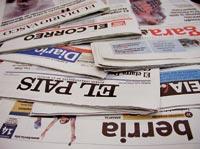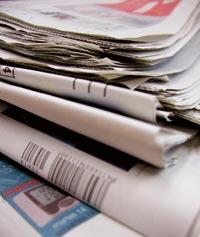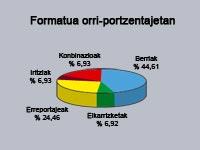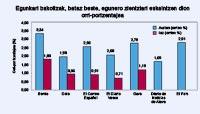Science in the daily press
2005/07/01 Kortabarria Olabarria, Beñardo - Elhuyar Zientzia Iturria: Elhuyar aldizkaria

2.42% of the total news published in the daily press refer to scientific topics. This is the main conclusion of the daily press analysis carried out by the Elhuyar Foundation for the second consecutive year. In other words, the number does not seem very high, but the difference with respect to the previous year is evident, since the number of news has doubled.
The study used the newspapers Berria, Deia, Gara, El Diario Vasco, El Correo Españo l, Diario de Noticias de Alava and El País. That is, all those published in the Autonomous Community of the Basque Country, plus El País. This Spanish newspaper has a certain referentiality in the dissemination of science and therefore has been used in the study. From last November to April of this year have been reviewed, read and signed daily news, reports, interviews, etc. published in the seven newspapers. In addition to daily issues, newspaper supplements have been analyzed.
Work without label
Beyond the data that can be considered common in these cases, such as the date of publication, the title, the journalistic format, whether it is signed or not, the topic, the mention of the sources, etc., there is one aspect that can be highlighted with respect to the study of the previous year: the quality. That is, with the collection of cold data we wanted to assess the information published. Consequence? Newspapers have a lot to improve when it comes to reporting on science.

To reach this conclusion, a score has been given to the articles according to different parameters, in order to indicate the degree of correct elaboration of the same. The correctness of the contents, the mention of the sources, the reliability or not of the sources to which reference is made, the opinion of the experts, the information beyond the news, the suitability and accuracy of the graphic explanations and the valuation of the writing, whether it is erroneous, simple or correct. Taking into account all these considerations, between 0 and 9 it has been calculated that a properly worked article should
reach a minimum score of 5.
At this minimum level there have come far fewer articles than you might think: 53% is accurate, that is, more than half have been correct, but less than half should be considered bad.
By extension, criticism can also be extended to the recipients of information, even if it is more diffuse. As newspaper buyers, buyers have the right to consume quality products and, of course, to demand it.
It is also possible to take reflection or criticism even further, even if we do not know how far. It may happen that the buyer does not realize that half of the information on science and technology he is receiving is of low quality. In this case, the problem seems more serious, because we should focus on the educational models of this society.
Writer Edonor
Apart from the quality issues and the recipients of the information, but without breaking the link, the analysis has also taken into account the author of the information. This can have a lot to do with the issue of quality. Is there a scientific outreach profile in the newspapers? Are there people specialized in socializing science and technology in newspapers? These questions have been answered. The records of the 4,489 articles published between November and April have been observed.
It has been proven who has signed the articles and, for whom we have this trade, a hopeful result: the figure of the scientific journalist has not been fully extended. In every newspaper there are people who write science and technology, but they do not fill in all the pages that the newspapers offer to this subject. Therefore, many articles go through journalists without specialization.
The study has also focused on other sections of scientific disclosure. For example, you have to know how much space each newspaper devotes to science, and in percentages Berria is the one that gives the most space, while Deia is the one that gives the least.
As for the presence of Basque, this year is less than the previous year, 20%, 38%. In fact, the number of articles written in Basque has increased, but the number of news devoted to science has increased. Interestingly, all newspapers, including El País, have written something about science in Basque. One of them has remained empty, in just six months not even in Basque: the Spanish Mail, which is sold mainly in Bizkaia and Araba.






